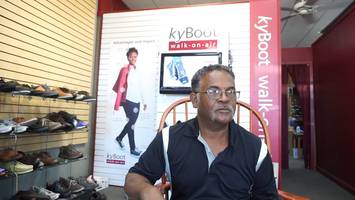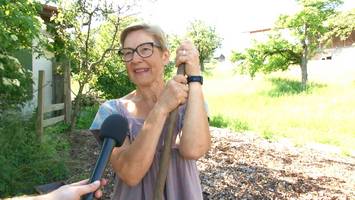Bone fracture
After a bone has healed successfully, the affected individual can once again perform all activities as before in most cases since bone tissue can fully regenerate.
Even when successfully healed, affected individuals can feel weakness for some time, preventing them from achieving full physical performance again. This is due to the bone itself on the one hand, since it has to get used to the load again, and to the training deficit of the muscular tissue and ligaments on the other hand.
kybun helps you gently train your body without overstraining it after the successful healing of a fracture. The bone can gradually get used to increased loads while the muscular tissue and ligament apparatus are strengthened.
Definition
A broken bone or fracture is a break in the continuity of a bone with the formation of two or more pieces (fragments), and with or without shifting (dislocation).
Unlike other tissue, which usually heals as scar tissue of lower quality, bones are able to fully repair themselves. Regardless of primary or secondary healing of the fracture, the full integrity and stability of the bone is restored by the end of the healing process. How long this takes depends on which bone is affected, among other things. Four to six weeks is normal for metacarpus or forearm bones, while the shin bone takes ten to twelve weeks.
This process is impaired in cases of bone fracture healing disturbance. Delayed healing of a fracture means that a broken bone is not exhibiting any signs of bone healing within the normal healing time – which depends on the affected bone as explained above. If the fracture fails to heal for more than six months, it is called pseudarthrosis.
Causes
Bone fractures are usually caused by direct or indirect force during an accident, a fall, impact or blow. A bone can also fracture partly or entirely due to acute, repeated excessive strain. An example of such a fatigue fracture is a marsh fracture of a metatarsus bone, also called a stress fracture.
A broken bone often comes with other injuries. On the one hand, the bone fracture itself can damage neighbouring vessels and nerves or a broken bone that extends into a joint may be accompanied by a joint dislocation. The accident can cause multiple injuries, including injuries to internal organs, intracranial injuries or major wounds and lesions. Particularly severe multiple injuries constitute a polytrauma.
Possible causes of bone fracture healing disorder:
- Insufficient stability and failure to rest the fracture, too great a distance between the bone fragments, or soft tissue that protrudes into the fracture gap and prevents proper contact.
- Smoking, nutritional disorders and underlying disorders that impair circulation, such as diabetes or osteoporosis, are among the physiological/biological factors that increase the risk of a bone healing disorder.
- In cases of open fractures with severe damage to the surrounding tissue, there may also be insufficient circulation in the fracture area. A further important cause of bone healing disorders is infections in the bone itself or in the soft tissue around the fracture. There are also certain medications that inhibit wound healing in general and thus also the healing of bones. These include cortisone and the cytotoxic agents used in cancer treatment.
Long-term consequences
Normally, a simple fracture grows back together successfully following conservative therapy or surgical intervention, and bone function is completely restored.
But there can be complications in some cases. Here are a few examples:
- Injuries to nerves, blood vessels, joints or other adjacent structures.
- Compartment syndrome (risk is especially great in cases of lower leg breaks)
- Infection
- Pseudarthrosis (wound healing disorder)
- Complex regional pain syndrome
Conventional therapy
Essentially, the decision must be made for either conservative fracture treatment, such as fixing the fracture with a plaster cast, or surgical treatment. Conservative treatment includes closed reduction, under general anaesthesia, of bone fragments that are out of position, with the subsequent application of a plaster cast. A surgical procedure usually involves the open reduction of bone fragments and fixation by means of osteosynthesis
The kybun principle of operation – being proactive
Following successful bone healing (complete bone fusion):
- kybun, with its soft, elastic material, offers gentle training for the regeneration of muscle power and ligament stability. This stabilises the joints and restores your confidence in your body.
- The impact of hard surfaces is absorbed, allowing the bone to gradually become accustomed to the greater load and reducing load-related pain.
With wound healing disorders:
- As long as there is still a chance of healing, the fracture should definitely remain immobilised. kybun should not be used during immobilisation because both the kybun mat and the kybun shoe are designed to mobilise the body.
- For certain disorders (such as Charcot foot), or for existing pseudarthrosis for which there is no chance of healing, the situation must be evaluated on an individual basis.
- In such cases, we recommend comprehensive consultation at the point of purchase, but also by the attending doctor, before you purchase a kybun shoe. It is also very important that you try out the products (kybun shoe and kybun mat) yourself in order determine whether they are beneficial for you.
The use of a kybun mat is recommended in any case, since training with it is of limited duration. If, after increasing training intensity you notice that you feel good on the kybun mat and would like a training device for use while out and about, you can still purchase a kybun shoe at a later time. - You will need to weigh the advantages and disadvantages of kybun:
Loads will be placed on the fracture in any shoe, including an orthopaedic shoe. In contrast to orthopaedic shoes, which stabilise the foot and tend to have a rigid construction, the kybun shoe provides the foot with much more freedom of movement, which allows a physiological rollover of the foot even with a variety of musculoskeletal movement impairments. In the long term, you can train your muscles in this way and have a significant influence on a healthy gait pattern.
Where there is poor foot sensitivity (as occurs in diabetes or Charcot foot), the affected person may have difficulty in recognising initial reactions in time to properly adjust dosage (wearing duration). The affected person must be conscious of this and should only wear the kybun mat/kybun shoe for short periods in the beginning.
Initial reactions
Specific initial reactions after a consolidated bone fracture
As the bone is in the beginning sensitive to pressure, even after successful fusion, the instability of the kybun shoe / mat can unsettle and be a challenging task. After a bone fracture, the patient must first regain confidence in his or her body, which takes time and careful rehabilitation training. Please read the "Application Tips" and contact your local kybun representative if you have any further questions.
For general initial reactions regarding the kybun mat and shoe, first time users should click here: Initial reactions
kybun exercises
Application tips
- Do not use kybun products until the fracture is stable.
- Exceptions include certain disorders and pseudarthroses, for which kybun use must be evaluated and adapted individually. Please contact a local kybun dealer where you can test the kybun products and receive personal advice.
- Selecting the right dosage – adjusting the duration of wearing the kybun shoe/standing on the kybun mat to your personal needs – is very important in the beginning. It is better to walk shorter distances on ordinary surfaces at first, so your body can adjust to the challenge of walking with the kybun shoe/standing on the kybun mat.
- Gradually increase the duration of use at your discretion until the strength and coordination of your feet is sufficient for walking in the kybun shoe for several hours. For some people, this is possible after just a few days while others take longer. It is highly individual.
The kybun shoe is a training device and can, but does not have to, become an everyday shoe later. - Be sure to maintain correct foot position on the kybun mat/in the kybun shoe. This means that the foot should stand straight on the soft, elastic material without lateral/medial rolling of the ankle joint. Any lateral/medial rolling of the ankle joint on the kybun mat/in the kybun shoe is usually not the fault of kybun but is caused by foot weakness , which has to be gradually alleviated through training. You will notice immediately when you place one-sided strain on your feet because the sole yields in the corresponding area.
- Try to focus on the foot position and correct lateral/medial rolling of the ankle joint. This strengthens your foot musculature so that, with time, you no longer tip sideways. Make sure that your body does not cramp up. Read more under ‘Lateral/medial rolling of the ankle joint’.
- Be sure not to take steps that are too long; that makes it easier to stabilise the foot over the kybun sole and reduces the tendency towards lateral/medial rolling of the ankle joint.
- If walking upright in the kybun shoe is no longer possible or you notice that you are ‘standing beside the shoe’ and are unable to correct this any longer, take this as a sign of body fatigue that means that you should take a short break from the kybun shoe.
- If your foot musculature is weak, it may make sense to acquire a model with a lower rebound effect when you first purchase the kybun shoe. This sole is more stable in the midfoot section. (Please consult your kybun shoe dealer for further information.)
- Try various kybun shoes; some models with a higher cut provide more stability.
- If you still feel too insecure walking in the kybun shoe, the kybun mat is the ideal device to carefully train and develop the foot and leg musculature. Please give your body time, and do not give up too quickly.
The kybun mat is available in three different thicknesses. This allows you to choose the thickness that is most comfortable for you (the thicker, the more unstable, the more intensive the training).
You can also hold on to a fixed object if you need additional support when using the kybun mat.












